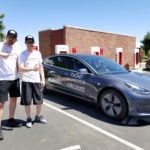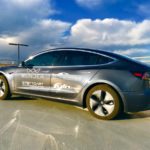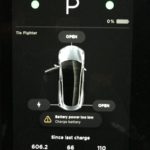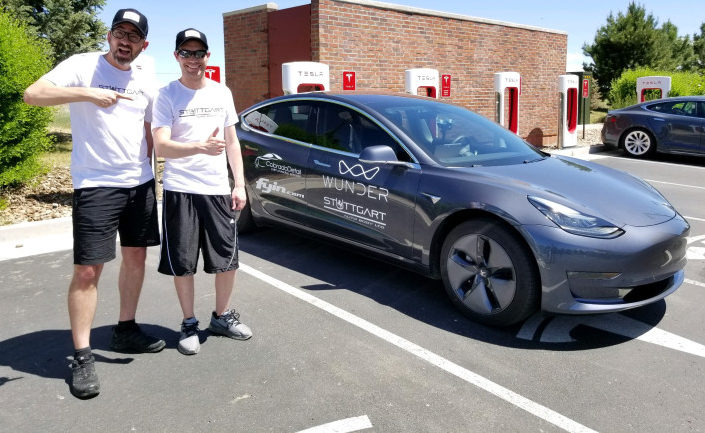
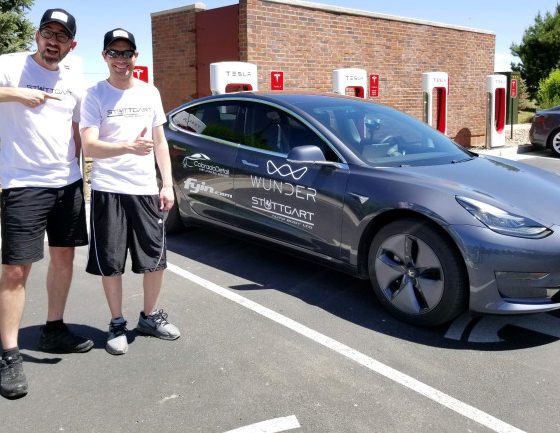
Lifestyle
Tesla Model 3 surpasses 600-mile mark in hypermile Guinness attempt
Less than a couple of weeks since setting a hypermile run record for the Model 3, Denver Tesla Club president Sean Mitchell, accompanied by Erik Strait, a fellow Tesla owner and host to a popular YouTube channel, managed to push the compact electric car 606.2 miles on a single charge, possibly setting a new Guinness World Record in the process.
Sean and Erik’s hypermile run stands as the first time a Tesla Model 3 has breached the 600-mile barrier. The trip lasted 32 hours, almost double the 18 hours that Mitchell took during his previous hypermile attempt. According to the duo in their livestream of their Guinness Record attempt, their speed this time averaged around 20-35 mph, slightly different than the 30 mph that Mitchell adopted during his first run.
The Tesla enthusiasts posted updates to their social media accounts during the duration of the trip. On Saturday evening, Mitchell posted an update informing his Twitter followers that they have hit the 500-mile mark. During this time, the Model 3’s battery was down to 12%. The Model 3 had used up 55 kWh of its battery as well.
- The Tesla Model 3 used in the latest hypermile attempt. [Credit: Sean Mitchell/Twitter]
- The Tesla Model 3 used in the latest hypermile attempt. [Credit: Sean Mitchell/Twitter]
- The final stats of the Model 3 at the end of its hypermile run. [Credit: Sean Mitchell/Twitter]
By late Saturday evening, the pair crossed the 600-mile barrier. The Tesla Model 3 ultimately ran out of battery 606.2 miles (975 km) into the trip. According to an update posted by Mitchell on his Twitter page after the run, the electric car averaged 110 Wh/mi and consumed 66 kWh during the long, 32-hour journey. This is considerably longer than the 515.7 miles driven by Mitchell in his previous hypermile attempt.
The journey did not come without its challenges. During dinnertime on Saturday evening, Mitchell and Strait did not even stop for a meal. Instead, one of the pair’s friends decided to do a special burrito delivery, which Mitchell received through a fishing net he stuck out from the vehicle’s window. The pair also did not turn on the Model 3’s air conditioning, causing temperatures in the vehicle’s cabin to reach 108F at one point during the trip.
Mitchell and Strait’s hypermile run was sponsored by Boulder-based solar energy funding firm Wunder Capital. Wunder covered the costs of the trip and the Guinness Record submission. Stuttgart Auto Body, Colorado Detail, & Fyin.com also supported the hypermile run.
Guinness currently only has a listing for the longest distance traveled by an electric vehicle. The record, which was set in October last year, was established using a modified BMW 5-series that was specifically designed for the Guinness Attempt. A Tesla Model S P100D driven by Tesla Owners Italia managed to hit 670 miles on one charge last August 2017 as well — a feat that warranted a tweet from Elon Musk.
Officially verified as the first production electric car to exceed 1000km on a single charge! Congratulations Tesla Owners Italia!! https://t.co/r8fFZIFEP2
— Elon Musk (@elonmusk) August 5, 2017
In a statement to Teslarati, Mitchell and Strait described their experience during the recent hypermile run.
“It was amazing to me to see the support of the Tesla community. They were so supportive and encouraging of our efforts. They only did they support us by tuning into the livestream but they also, to our surprise, donated money through YouTube. The Model 3 is such a new car. This hypermile shows that not only is the Model 3 amazingly engineered for the masses, but EVs are a viable option for everyone,” Mitchell noted.
“It certainly brought attention to EVs in general and helped bring awareness about Teslas. We hopefully helped discourage range anxiety, even though we were an extreme case. We showed what Teslas are truly capable of. Also, by livestreaming the entire event, we had a lot of people tune in and ask a lot of good questions related to Tesla that we were able to help answer and clarify,” Strait stated.
The Model 3’s battery capacity and range have become some of the biggest advantages of the vehicle. Consumer Reports, which did not give the Model 3 a “Recommended” rating due to its braking distance, still stated that their car broke their records for range, managing to travel 350 miles on one charge.
Watch the final leg of Mitchell and Strait’s record-setting hypermile run in the video below.

Lifestyle
Tesla Model S Plaid battles China’s 1500 hp monster Nurburgring monster, with surprising results
There is just something about Tesla’s tuning and refinement that makes raw specs seem not as game-changing.

The Tesla Model S Plaid has been around for some time. Today, it is no longer the world’s quickest four-door electric sedan, nor is it the most powerful. As per a recent video from motoring YouTube channel Carwow, however, it seems like the Model S Plaid is still more than a match for some of its newer and more powerful rivals.
The monster from China
The Xiaomi SU7 Ultra is nothing short of a monster. Just like the Model S Plaid, it features three motors. It also has 1,548 hp and 1,770 Nm of torque. It’s All Wheel Drive and weighs a hefty 2,360 kg. The vehicle, which costs just about the equivalent of £55,000, has been recorded setting an insane 7:04.957 at the Nurburgring, surpassing the previous record held by the Porsche Taycan Turbo GT.
For all intents and purposes, the Model S Plaid looked outgunned in Carwow’s test. The Model S Plaid is no slouch with its three motors that produce 1,020 hp and 1,420 Nm of torque. It’s also a bit lighter at 2,190 kg despite its larger size. However, as the Carwow host pointed out, the Model S Plaid holds a 7:25.231 record in the Nurburgring. Compared to the Xiaomi SU7 Ultra’s record, the Model S Plaid’s lap time is notably slower.
Real-world tests
As could be seen in Carwow’s drag races, however, Tesla’s tech wizardry with the Model S Plaid is still hard to beat. The two vehicles competed in nine races, and the older Model S Plaid actually beat its newer, more powerful counterpart from China several times. At one point in the race, the Xiaomi SU7 Ultra hit its power limit due to its battery’s temperature, but the Model S Plaid was still going strong.
The Model S Plaid was first teased five years ago, in September 2020 during Tesla’s Battery Day. Since then, cars like the Lucid Air Sapphire and the Xiaomi SU7 Ultra have been released, surpassing its specs. But just like the Model Y ended up being the better all-rounder compared to the BYD Sealion 7 and the MG IM6, there is just something about Tesla’s tuning and refinement that makes raw specs seem not as game-changing.
Check out Carwow’s Model S Plaid vs Xiaomi SU7 drag race video below.
Lifestyle
500-mile test proves why Tesla Model Y still humiliates rivals in Europe
On paper, the BYD Sealion 7 and MG IM6 promised standout capabilities against the Model Y.

BYD is seeing a lot of momentum in Europe, so much so that mainstream media has taken every opportunity to argue that the Chinese automaker has beaten Tesla in the region. But while BYD sales this year in Europe are rising and Tesla’s registrations remain challenged, the raw capabilities of vehicles like the Model Y are difficult to deny.
This was highlighted in a 500-mile challenge by What Car? magazine, which showed that the new Tesla Model Y is more efficient, cheaper to run, and more reliable than rivals like the BYD Sealion 7, and even the nearly 400 KW-charging MG IM6.
Range and charging promises
On paper, the BYD Sealion 7 and MG IM6 promised standout capabilities against the Model Y. The Sealion 7 had more estimated range and the IM6 promised significantly faster charging. When faced with real-world conditions, however, it was still the Model Y that proved superior.
During the 500-mile test, the BYD nearly failed to reach a charging stop, arriving with less range than its display projected, as noted in a CarUp report. MG fared better, but its charging speeds never reached its promised nearly-400 kW charging speed. Tesla’s Model Y, by comparison, managed energy calculations precisely and arrived at each stop without issue.
Tesla leads in areas that matter
Charging times from 25% to 80% showed that the MG was the fastest at 17 minutes, while Tesla and BYD were close at 28 and 29 minutes, respectively. Overall efficiency and cost told a different story, however. The Model Y consumed 19.4 kWh per 100 km, compared to 22.2 for MG and 23.9 for BYD. Over the full trip, Tesla’s charging costs totaled just £82 thanks to its supercharger network, far below BYD’s £130 and MG’s £119.
What Car? Magazine’s testers concluded that despite BYD’s rapid sales growth and the MG IM6’s seriously impressive charging speeds, Tesla remains the more compelling real-world choice. The Model Y just offers stability, efficiency, and a proven charging infrastructure through its Supercharging network. And as per the magazine’s hosts, the Model Y is even the cheapest car to own among the three that were tested.
Watch What Car? Magazine’s 500-mile test in the video below.
Lifestyle
Tesla Cybertruck slapped with world’s least intimidating ticket, and it’s pure cringe
One cannot help but cringe and feel second-hand embarrassment at the idea of a person just driving around with a stack of these babies.

A Cybertruck parked at Stanford Shopping Center in California was recently hit with what might be the most try-hard piece of paper ever slipped under a wiper blade: a “fake citation” accusing the driver of supporting a “fascist car.”
The note, shared on X by Tesla staff program manager Ryan Torres, quickly made the rounds on X, where it quickly gained attention as an example of how not to protest.
The world’s least intimidating ticket
According to the citation, the supposed “violation” was “driving a fascist car.” The remedial action? Take the bus, call an Uber, or ride a bike. The note also dubbed Elon Musk a “chainsaw-wielding Nazi billionaire.” Now, protests against Tesla and Elon Musk have become commonplace this year, but one cannot help but cringe and feel second-hand embarrassment at the idea of a person just driving around with a stack of fake anti-Tesla/Musk citations.
Torres pointed out the irony himself in his post on X. Tesla currently employs over 140,000 Americans, and SpaceX has put the U.S. firmly back at the top of space technology. As Torres put it, maybe the person behind the world’s least intimidating ticket should “read a book on innovation before vandalizing” other people’s property.
Peak performative clownery
Not to mention that the fake ticket’s logic collapses under its own weight. EVs like the Cybertruck are literally designed to reduce emissions, not “destroy the economy.” If anything, Tesla has bolstered the United States’ economy by fueling jobs in engineering, manufacturing, and clean energy. It’s not the first time a Tesla has been the target of vandalism or politically charged notes, but this one stands out for sheer cringe value.
Torres summed it up neatly: “Peak clownery.” On that point, at least, the citation earns full marks. In a way, though, perhaps cringe fake tickets are not as bad as the literal firebombs that were being thrown at Tesla stores and cars earlier this year because some critics were gleefully misinformed about Elon Musk.
